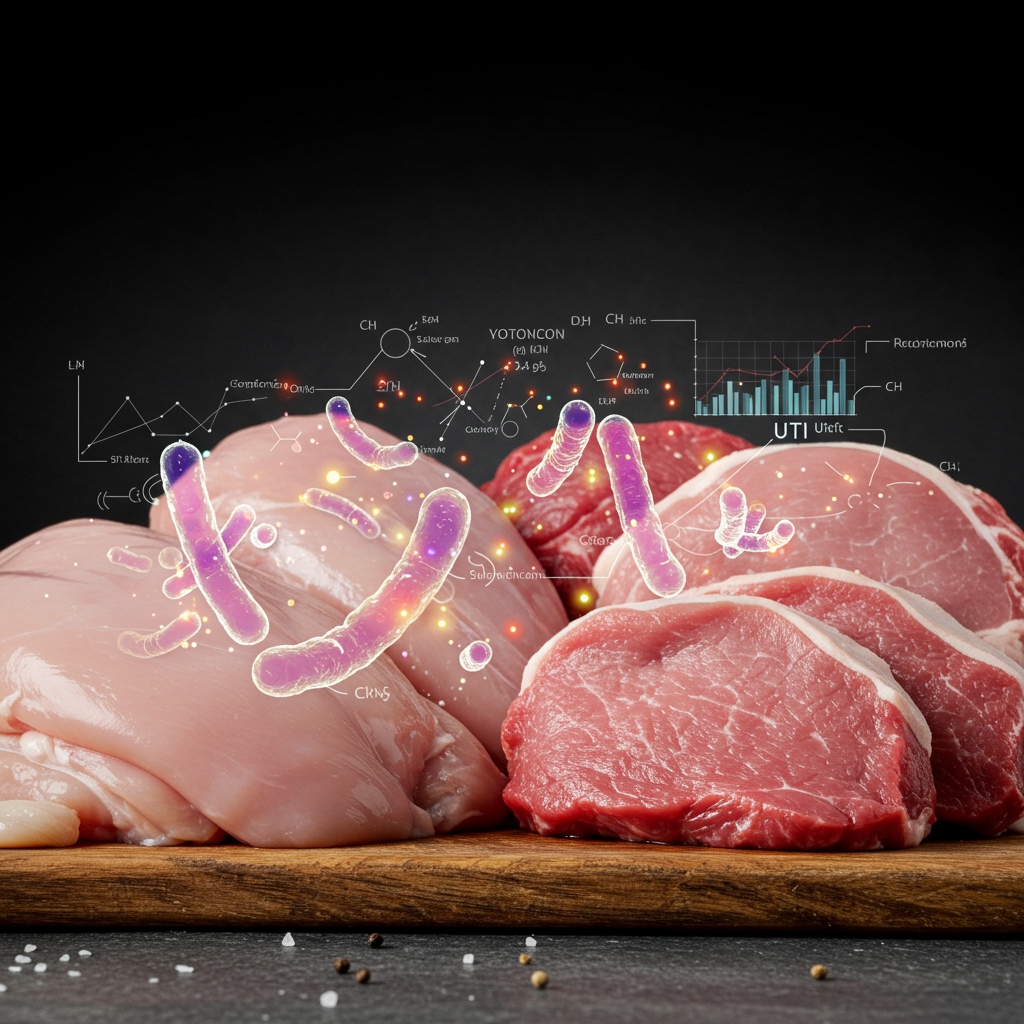Could your last meal be quietly contributing to a painful urinary tract infection? Recent groundbreaking research reveals a startling connection between common meats like chicken, turkey, pork, and beef, and the occurrence of UTIs. This challenges the long-held belief that these common infections are solely a result of hygiene or sexual activity, introducing a critical new dimension to understanding and preventing UTIs. This isn’t just about food poisoning; it’s about a hidden pathway for bacteria that impacts millions annually.
Unveiling a Hidden Cause of UTIs
Urinary tract infections (UTIs) are a widespread health concern, affecting millions globally each year. Traditionally, these infections are understood to stem from bacteria entering the urethra due to factors like improper hygiene or sexual contact. However, a significant four-year study, published in the journal mBio, has brought a surprising new culprit to light: contaminated meat. Researchers in Southern California found that nearly one in five UTIs among their patient group were directly linked to E. coli bacteria originating from the meat they consumed.
This discovery builds on earlier estimates, including a 2023 study from George Washington University, which suggested that foodborne E. coli could account for up to 640,000 UTIs in the United States every year, representing about 8% of total cases. These findings underscore a critical oversight in public health: the E. coli strains responsible for these foodborne UTIs are often different from those causing typical diarrheal illnesses and are currently not routinely monitored in the U.S. food supply or farm animals by federal agencies like the USDA or FDA.
How Does Meat-Borne E. coli Lead to a UTI?
The journey from your plate to a painful UTI might seem complex, but the mechanism is quite straightforward. E. coli bacteria are naturally present in the digestive tracts of humans and warm-blooded animals. During the slaughtering and processing of meat, these bacteria can easily contaminate the product.
When you handle raw meat during cooking or consume undercooked portions, these E. coli strains can enter your digestive system. From there, they colonize your gut. Later, through everyday actions like wiping after using the bathroom or even cross-contamination from hands that touched raw meat, these bacteria can migrate from the rectal area to the urethra. Once in the urethra, they can ascend into the bladder and urinary tract, initiating an infection. Unlike many foodborne illnesses that trigger immediate gastrointestinal symptoms, these UTI-causing E. coli often don’t cause diarrhea or vomiting, making their origin harder to trace without specific genetic analysis.
The Science Behind the Link: Genetic Tracing
The pivotal research involved a collaboration between scientists at George Washington University and Kaiser Permanente. From 2017 to 2021, they collected over 2,300 E. coli-positive urine samples from patients in Southern California. Concurrently, more than 3,300 meat samples (chicken, turkey, pork, beef) were gathered from major grocery stores in the same region.
A specialized lab at George Washington University then performed genetic analysis, comparing the DNA signatures of the E. coli strains found in human infections with those isolated from the meat products. Dr. Martin Blaser, a microbiologist from Rutgers University not involved in the study, noted that “Strains have different DNA signatures, and you can see whether the strains in the animals and the strains in the people match up or not. And they found a number of matches.” This meticulous genetic fingerprinting provided compelling evidence linking specific human UTIs directly to bacteria found in the purchased meat. Among the sampled meats, chicken and turkey products exhibited the highest rates of E. coli contamination, suggesting they may pose a greater risk.
Disparities in Risk: Socioeconomic Factors
Beyond the direct link to meat, the study also uncovered troubling socioeconomic disparities in UTI risk. Researchers observed that individuals living in low-income neighborhoods in Southern California faced a 60% higher risk of acquiring a foodborne UTI compared to those in wealthier areas.
Study co-author Lance Price, a professor of environmental and occupational health at George Washington University, and his team proposed several reasons for this concerning gap. These could include less stringent food handling practices in some grocery stores, such as inadequate storage temperatures or products being left out for too long. Price himself recounted observing poorly packaged, “bloated” chicken, containing saline and often drug-resistant bacteria, spilling onto conveyor belts in some stores. This highlights a critical public health equity issue, where vulnerable populations may be disproportionately exposed to contaminated food sources. Furthermore, the research identified women and older men as particularly vulnerable demographics for UTIs originating from meat sources, often due to anatomical susceptibility (in women) or other health factors (in older men).
The Looming Threat: Antibiotic Resistance
The implications of foodborne UTIs extend beyond just the initial infection; they intertwine with the escalating global crisis of antibiotic resistance. The worldwide incidence of UTIs surged from 252 million in 1990 to 405 million in 2019, with associated deaths more than doubling. A major factor driving this increase in severity and mortality is the growing resistance of E. coli strains to common antibiotics.
A significant contributor to this problem is the widespread use of antibiotics in intensive farming. Farm animals are routinely given antibiotics, often not to treat existing illnesses, but to prevent disease and promote growth. This practice creates an environment where only the strongest, most resistant bacteria survive and proliferate. When these resistant E. coli strains contaminate meat and subsequently cause human UTIs, they become much harder to treat. Michelle Van Kuiken, a urologist at the University of California, San Francisco, explains that consuming meat from animals treated with antibiotics can introduce these resistant bacteria into the human microbiome, potentially leading to infections that require stronger, sometimes less effective, antibiotics. While thorough cooking typically kills these bacteria, cross-contamination remains a major risk for transmitting these resistant strains.
Essential Strategies for Prevention
While the news about contaminated meat might be concerning, it doesn’t mean you need to give up meat entirely. The key lies in adopting rigorous food safety practices and understanding how to mitigate risk. Doctors typically treat UTIs with the same antibiotics regardless of the E. coli‘s origin, as the source is rarely known during diagnosis. Therefore, proactive prevention is your best defense.
Kitchen Hygiene: Your First Line of Defense
Assume Contamination: Experts like Dr. Price recommend assuming all raw meat, especially chicken and ground turkey, is potentially contaminated with E. coli.
Thorough Cooking: Always cook meat to the correct internal temperatures. This is crucial for killing bacteria, including E. coli.
Prevent Cross-Contamination: This is perhaps the most critical step.
Separate Everything: Keep raw meat physically separate from other foods, especially produce and ready-to-eat items.
Dedicated Tools: Use separate cutting boards, knives, and bowls for raw meat and poultry. Color-coding these can be a helpful visual cue.
Wash Surfaces Thoroughly: Clean all kitchen surfaces, cutting boards, and utensils that come into contact with raw meat with hot, soapy water immediately after use. Juices and aerosols can spread bacteria widely.
Meticulous Handwashing: Wash your hands thoroughly with soap and water for at least 20 seconds after handling raw meat or poultry. This simple act dramatically reduces bacterial transfer.
Correct Storage: Store raw meats and poultry on the lower shelves of your refrigerator, beneath ready-to-eat items. This prevents any drips from contaminating other foods. The study authors also advocate for stricter regulatory measures, specifically calling for universal leak-proof packaging for all meat products to prevent spills in stores and homes.
Beyond the Kitchen: General UTI Prevention
In addition to safe meat handling, reinforce general UTI prevention practices recommended by health experts:
Hydration: Drink plenty of water throughout the day to encourage frequent urination, which helps flush bacteria from your urinary tract.
Post-Sex Urination: Urinate immediately after sexual activity to help flush out any bacteria that may have entered the urethra.
Wiping Technique: Always wipe from front to back after using the toilet to prevent bacteria from the bowel from entering the urethra.
Hygiene Choices: Opt for showers instead of baths. Avoid douching, feminine sprays, and scented products in the genital area, as these can disrupt natural bacterial balance.
Consider Meat Sourcing: Dr. Price suggests that consumers might consider purchasing meat products labeled “raised without antibiotics” or “USDA organic.” While not eliminating E. coli risk, these products are less likely to contain antibiotic-resistant strains, making potential infections easier to treat.
The Serious Risks of Untreated UTIs
Understanding the potential sources of UTIs is crucial because these infections, if left untreated, can lead to serious and even life-threatening complications. Initial symptoms often include painful and frequent urination, a persistent urge to urinate, and sometimes cloudy or bloody urine.
However, if the infection ascends from the bladder to the kidneys (a condition called pyelonephritis), symptoms can worsen to include fever, chills, lower back pain, nausea, and vomiting. From the kidneys, E. coli can enter the bloodstream, leading to a dangerous condition known as sepsis. As Professor Lance Price warns, “The bladder is a major gateway to the bloodstream for E. coli. And when you get these E. coli in your blood, they can kill you.” This underscores the importance of seeking prompt medical attention if you suspect you have a UTI.
Frequently Asked Questions
How can contaminated meat lead to a urinary tract infection?
Contaminated meat can cause UTIs when E. coli bacteria, present in raw or undercooked meat, enter your digestive system. These bacteria then colonize your gut. From the gut, E. coli can transfer to the urethra, often through improper hygiene or cross-contamination from hands that handled raw meat, and subsequently ascend into the urinary tract. The E. coli strains linked to these foodborne UTIs typically do not cause gastrointestinal symptoms like diarrhea, making their origin less obvious than traditional food poisoning.
What specific precautions should I take to prevent UTIs from contaminated meat?
To minimize your risk, practice strict kitchen hygiene: always cook meat thoroughly to its safe internal temperature. Prevent cross-contamination by using separate cutting boards and utensils for raw meat and other foods. Wash your hands thoroughly with soap and water after handling raw meat. Store raw meat on lower refrigerator shelves to prevent drips. Additionally, consider purchasing meat labeled “raised without antibiotics” to reduce exposure to antibiotic-resistant E. coli strains, should contamination occur.
Are certain types of meat or populations at higher risk for foodborne UTIs?
Yes, research indicates that chicken and turkey products tend to have the highest rates of E. coli* contamination among sampled meats. Studies also show significant demographic disparities, with individuals in low-income neighborhoods facing a 60% higher risk of foodborne UTIs compared to those in wealthier areas, potentially due to differences in grocery store handling practices. Furthermore, women and older men are identified as particularly vulnerable to UTIs stemming from meat sources.
Taking Control of Your Health
The link between contaminated meat and urinary tract infections is a crucial public health finding, adding a new layer to our understanding of these common yet potentially severe infections. By combining meticulous food safety practices with general UTI prevention strategies, you can significantly reduce your personal risk. This includes diligent kitchen hygiene, mindful meat choices, and proactive steps like proper hydration and post-sex urination. If you experience symptoms of a UTI, seek medical attention promptly, as early treatment is vital to prevent serious complications. Understanding this connection empowers you to take greater control over your health and well-being.




